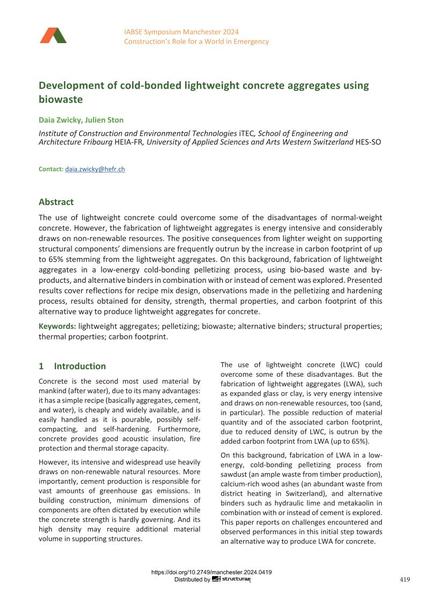Development of cold-bonded lightweight concrete aggregates using biowaste

|
|
|||||||||||
Bibliographic Details
| Author(s): |
Daia Zwicky
(Institute of Construction and Environmental Technologies iTEC, School of Engineering and Architecture Fribourg HEIA-FR, University of Applied Sciences and Arts Western Switzerland HES-SO)
Julien Ston (Institute of Construction and Environmental Technologies iTEC, School of Engineering and Architecture Fribourg HEIA-FR, University of Applied Sciences and Arts Western Switzerland HES-SO) |
||||
|---|---|---|---|---|---|
| Medium: | conference paper | ||||
| Language(s): | English | ||||
| Conference: | IABSE Symposium: Construction’s Role for a World in Emergency, Manchester, United Kingdom, 10-14 April 2024 | ||||
| Published in: | IABSE Symposium Manchester 2024 | ||||
|
|||||
| Page(s): | 419-427 | ||||
| Total no. of pages: | 9 | ||||
| DOI: | 10.2749/manchester.2024.0419 | ||||
| Abstract: |
The use of lightweight concrete could overcome some of the disadvantages of normal-weight concrete. However, the fabrication of lightweight aggregates is energy intensive and considerably draws on non-renewable resources. The positive consequences from lighter weight on supporting structural components’ dimensions are frequently outrun by the increase in carbon footprint of up to 65% stemming from the lightweight aggregates. On this background, fabrication of lightweight aggregates in a low-energy cold-bonding pelletizing process, using bio-based waste and by- products, and alternative binders in combination with or instead of cement was explored. Presented results cover reflections for recipe mix design, observations made in the pelletizing and hardening process, results obtained for density, strength, thermal properties, and carbon footprint of this alternative way to produce lightweight aggregates for concrete. |
||||
| Keywords: |
carbon footprint lightweight aggregates thermal properties structural properties pelletizing biowaste alternative binders
|
||||
